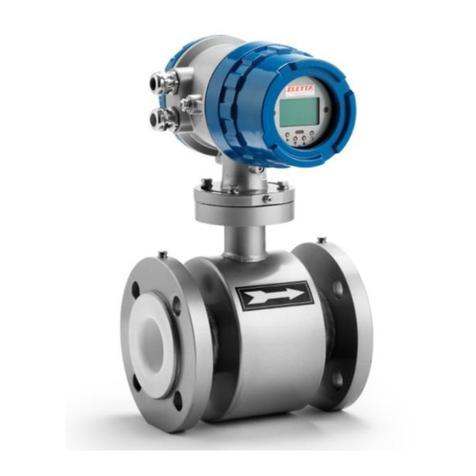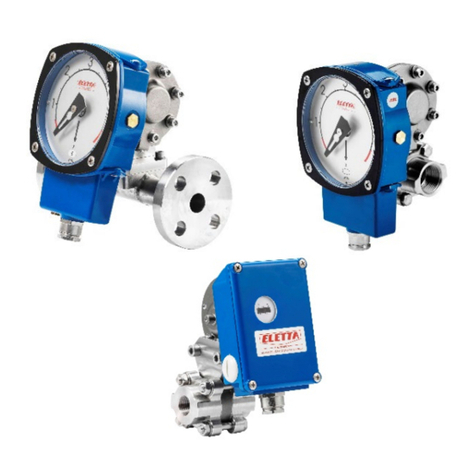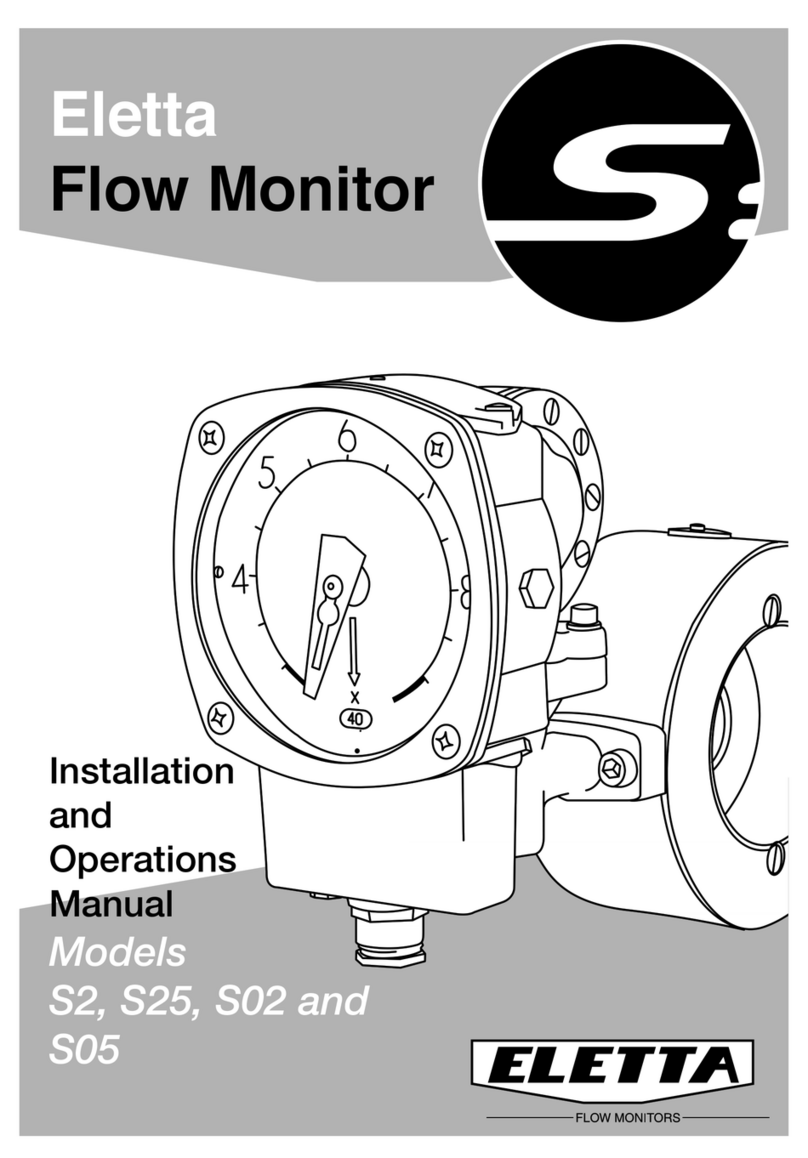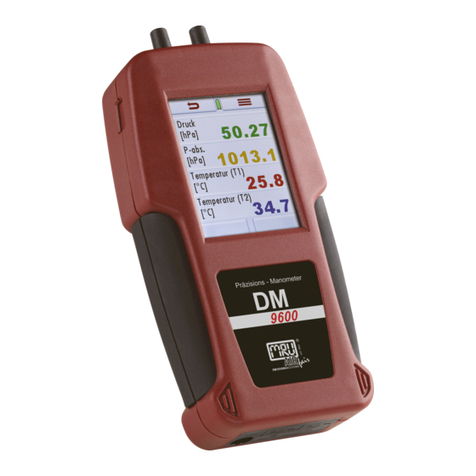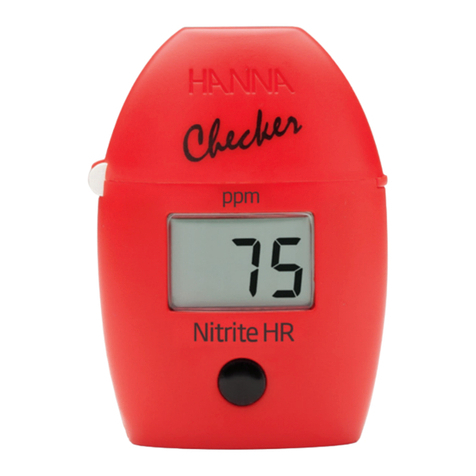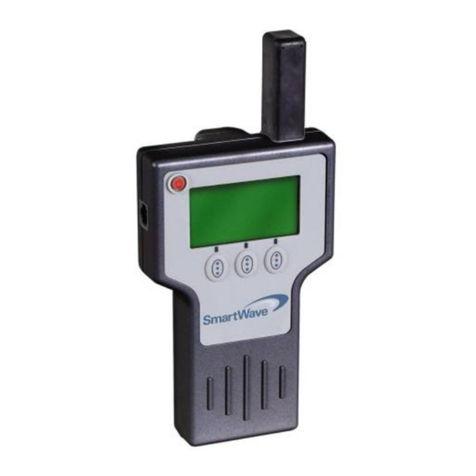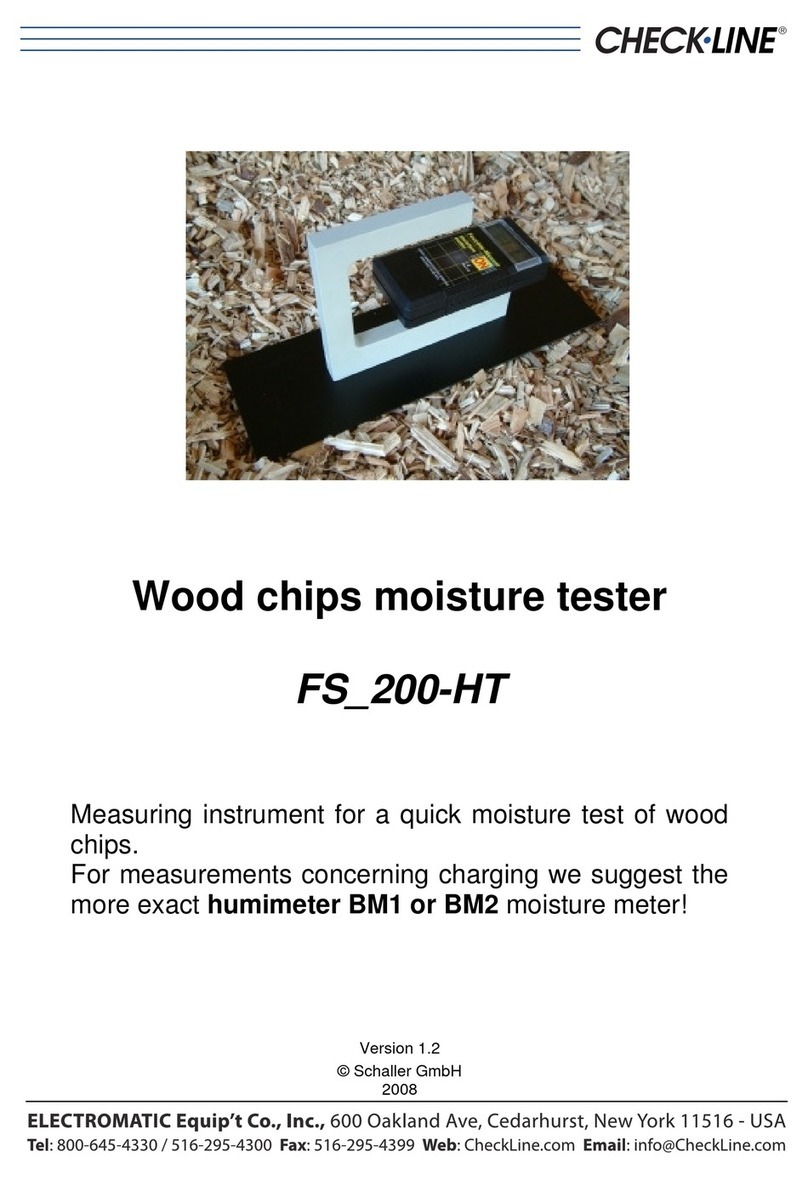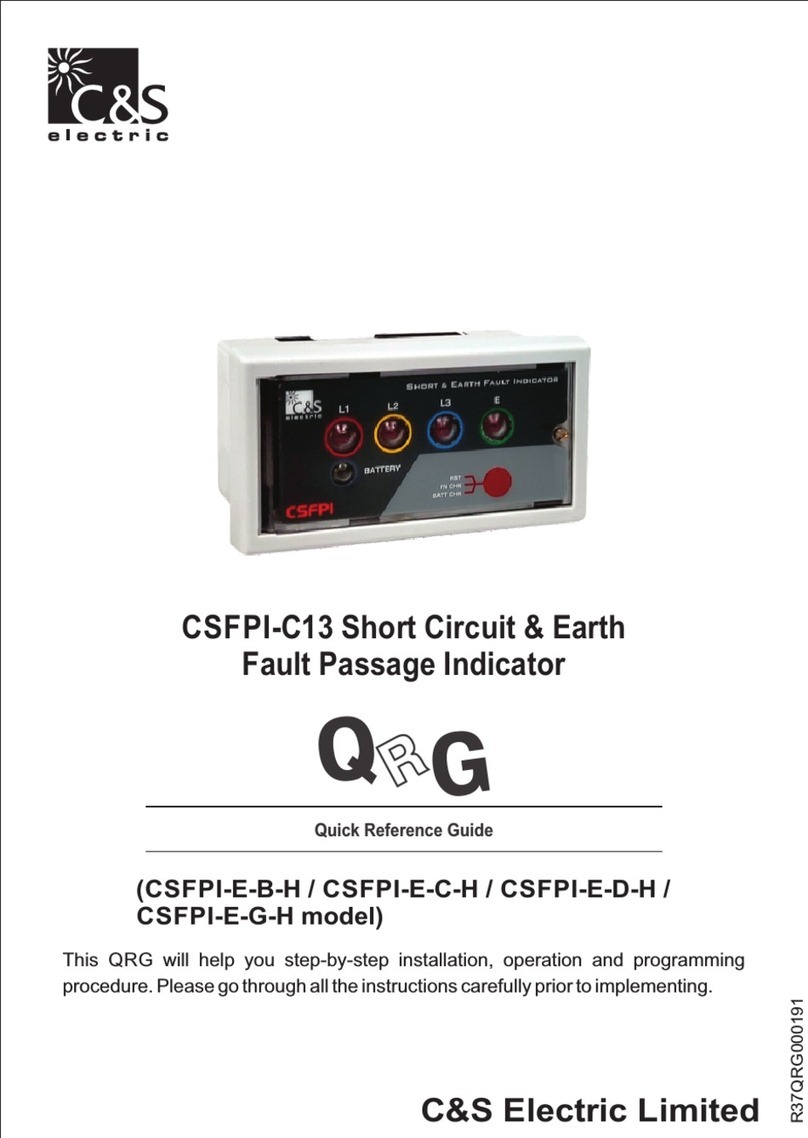Eletta S Series User manual

Manual
Eletta Flow Monitor
S-series
Modell
S2 o05
2021-11-15 5041F2E22

2
5041 2E1
About this manual
• This manual relates to the S-series Flow Monitor.
• Note that the latest version of this manual is always available as a PDF file
on our web site www.eletta.com.
• On our site you will find other interesting information such as our product
configurator where you can build your own Monitor, leaflets, certificates etc.
Proprietary Rights
This manual contains confidential technical data, including trade secrets and
proprietary information, that are the property of Eletta Flow AB, Sweden.
Any changes or alterations to downloaded or printed Eletta original docu-
mentation such as manuals, drawings, leaflets, etc, are not permitted without
a written permission from Eletta Flow AB, Sweden.
These data are only disclosed to you under permission of limited use within
your company. Use for manufacturing or processing is not permitted.
Any other use of data and information is strictly prohibited without prior
written permission from Eletta Flow AB, Sweden.
Distributors
Eletta has appointed a number of distributors all over the world. You will
find more information about your closest distributor at our web site
www.eletta.com, or by contacting our Customer Service Center.
Contact
Orders/inquiries: +468 603 07 80
Switchboard: +468 603 07 70
E-mail: info@eletta.com
Web: www.eletta.com
Address: Eletta Flow AB
P.O Box 5084
SE-141 05 Kungens Kurva
Sweden

3 5041 2E22
Contents
General Information ...........................................................................4
1.1
Description................................................................................4
1.2
Specifications............................................................................5
Installation ..........................................................................................9
2.1
Unpacking.................................................................................9
2.2
Procedures before Installation..................................................9
2.3
Installation of the Pipe Section...............................................10
2.4
Separate mounting of the Pipe Section and Control Unit......11
2.5
Installation and changing the Control Unit..............................13
2.6
Pressure Drop.........................................................................15
2.7
Electrical Installation...............................................................17
Operation ..........................................................................................18
3.1
Principle of operation, DP-Flow Measurement.......................18
3.2
Change of Flow Range...........................................................18
3.3
Adjustment of switch point, S2 and S25.................................20
3.4
Change of Flow Direction .......................................................22
3.4.1
Flow Direction Selector...........................................................22
3.5
Change of Dial Orientation .....................................................23
Trouble shooting...............................................................................24
4.1
Verification of Flow .................................................................24
4.2
Electrical connections.............................................................25
4.3
Spares.....................................................................................26
Tables..........................................................................................................27
5.1 Measuring Ranges..................................................................27
5.2 Weight and Dimensions..........................................................28
Spare Parts .......................................................................................29
6.1 Exploded Drawing S-GL/FA....................................................29
6.2 Exploded Drawing S-GSS/FSS..............................................31
6.3 Exploded Drawing S-SS-GSS/FSS…………………………….33
Distributors ..............................................................................35
Recycling…………………………………………………………..35
1
2
3
4
6
5
7
8

4 5041 2E22
1.1Description
The Eletta Flow Monitor is used to control and measure flow of liquids and
gases in pipes from size 15 mm to 500 mm (larger pipes as an option). They
have been manufactured for over 70 years and are well known for its reliabili-
ty. They are used where operational safety demands, efficient supervision and
rugged installation is needed, all over the world. Eletta Flow AB in Sweden is
certified according to ISO9001 and ISO14001.
The Eletta Flow Monitor is based on the proven and dependable differential
pressure principle, using interchangeable orifice plates for different measu-
ring ranges. The Flow Monitors are working with different differential
pressure ranges, i.e. 12,5 –50 and 50 –200 mbar for the S2/S02 / S2SS/S02SS
and 22 –550 mbar for the S25/S05 / S25SS/S05SS, depending on the desired
and ordered flow range. The same goes for our models; V1/V1SS/D2/D2SS
and V15/V15SS/D5 and D5SS. Due to the working principle of the
instrument, it is of outmost importance that the installation instructions
(chapter 2) are followed carefully in order to get the proper function of the
instrument.
The Instrument consists of two parts mainly i.e. the Pipe Section and the
Control Unit. The Pipe Section is the part that is to be mounted in the process
pipe and the Control Unit is mounted directly (standard) or remote on/to the
Pipe Section. The Control Unit is giving you the Flow information and it also
contains all electrical connections for input and output.
The covers for the flow monitors are available in two materials. Powder
coated aluminum (S2 / S25 / S02 / S05) and stainless steel (S2SS / S25SS /
S02SS / S05SS).
The Pipe Sections are available in different process connections with the fol-
lowing standards:
Threaded connections in BSP or NPT from 15 mm (1/2”) to 40 mm (1 1/2”)
depending on the chosen material of construction.
Flanged (wafer) connection from DN15 /PN16 (ANSI 1/2”/150 lbs) to DN
500/PN16 (ANSI 20”/150lbs) depending on the chosen material of construc-
tion.
The Control Units S02, S05, S02SS and S05SS have a local readout and S2, S25,
S2SS and S25SS are also equipped with two independent adjustable alarms
General Information
1

5 5041 2E22
(micro switches) which can be set for low and high flow alarm. The readout
has a scale, which shows you the ordered flow range with a multiplier as a
standard. The standard scales have the following designations; for S2/S02 /
S2SS/S02SS the scale goes from the number 4 to 8 (1:2 turndown). This is
the value that you have to multiply the small multiplier (sticker) figure at the
bottom of the scale with, in order to read the actual flow in the values you
have ordered i.e. liters/min, m3/hours, USGPM. etc. (also shown at the
bottom of the scale) For the S25/S05 / S25SS/S05SS, the scale goes from 1
to 5 and hence, this is the value you use together with the multiplier at the
bottom of the scale, to read the actual Flow through the Monitor. For the
S2/S02/S2SS and S02SS with low differential pressure range (12,5 –50 mbar),
the scale is customized and shows the direct value.
The Control Unit can also be fitted with a special ordered scale (direct reading
scales) as an option, for example, l/min, m3/h, USG/min etc. for easy reading
and then you have no multiplier at the bottom of the scale.
1.2Specifications
The only flow difference between the S2/S02 and S25/S05 is the turn down of
the flow range i.e. the S2/S02 has a 1:2 turn down (for example; 50 –100
l/min) and the S25/S05 has a turn down of 1:5 (for example; 20 –100 l/min).
Accuracy: <+/–5%F.S (fullscale) within20-80% of the chosenFlowrange
<+/–10%F.S.(fullscale)within100% ofthechosenFlowrange
The accuracy stated is achievable if the installation instruction
is followed given in this manual. It is recommended that you
always choose the Flow Range of the Flow Monitor so that the
normal flow is in the middle of the Monitor Flow Range.
Make sure that the expected alarm set points are within the
chosen flow range. For example: If you have a flow of 110
l/min maximum and the normal Flow is at 90 l/min, chose the
Eletta Flow Monitor S2 with a Flow Range of 60–120 l/min.
This will give you the highest accuracy since your flow is in
the middle of the Monitor Flow Range and give you a lower
pressure loss.
Repeatability: < 2 %
Pressure: Max:16 bar, (232 PSI), higher test pressure as an option.
Min: A line pressure of apr.: 0,7 –1,0 bar (10 –14,5 PSI) is
required for proper operation.
Temperature: Control Unit
–20°C to 90°C (–4°F to 200°F), standard
1

6 5041 2E22
Contact surfaces are silver plated asstandard.
Hystereses: +/–10%
Voltage: max. 460 VAC
Current: max.15 A
Inductive load: 15A @ 380VAC
0,03A @ 230 VAC
5A @ 30 VDC
Type: SPDT
–20°C to 120°C (-4°F to 250°F), optional
The lower temperature is not valid for Monitors equipped with
FPM soft parts. FPM is limited to –5 °C (23 °F).
Higher process temperature with remote installation of
Control Unit (separate mounting, see section 2.4)
These temperature limits are valid for models S2 and S25
(with micro switches)
Temperature limit for S02 and S05 is –20°C to 120°C (–4°F to
250°F). Pls note the FPM soft part remark above, which is
valid also for S02/S05 models.
Pipe Section: The pipe sections are equipped with spacers (holding the orifi-
ce plate) made of Polyamide plastic (PA)material and they can
handle liquid/gas temperature up to 120°C (248°F).
For higher process temperature, we recommend using the sta-
inless steel pipe section, which has no spacers.
Dial: 120 mm diameter with mechanical pointer and a linear scale.
Front glass: PC, Polycarbonate clear. PC/PBT black.
Process
connection: DN15 –40 (1/2” –11/2”) for GL-models
DN15 –25 (1/2” –1”) for GSS -models
DN15 –400 (1/2” –16”) for FA-models
DN15 –500 (1/2” –20”) for FSS-models
The models S2SS/S25SS / S02SS/S05SS are only available for
pipe sections GSS and FSS.
Alarm/
Contacts: S2, S25, S2SS and S25SS have 2 (two) micro switch SPDT
contacts, independently adjustable within the ordered Flow
range.
S02, S05, S02SS and S05SS has no micro switch contacts
included, only a dial for local indication of Flow.
Micro
switch spec:
Contact surfaces are silver plated as standard. Hysteresis:10%
Rated voltage: 480 VAC/15A
Breaking current: 15@125, 250, 480 VAC
Resistive load: 2A@30 VDC
0,4A@125 VDC
0,2A@230 VDC
Type: SPDT
1

7 5041 2E22
Material; Pipe Section
and Diaphragm
Housing: TypeGL; SM 2862 (B.S CZ132) de-zincificated –copper
For intrinsically safe (IS) applications, we recommend
ordering micro switches with gold plated contact surface,
which are better suited for the voltage and current limitations
in the Ex- regulations. As an option, hermetically sealed
micro switches are available (1HM1)
Protection Class:
Control Unit: IP43 (NEMA 3R), standard
IP65 (NEMA 4x), optional
Degreased and powder coated aluminum alloy or brushed
stainless steel.
Material; Diaphragm and pipe section:
Type GL: De-zincificated brass, CW602N, EN12420
Type GSS: Seaworthy stainless steel 1.4470
Type FA: Housing: De-zincificated brass, CW602N, EN12420
Pipe section: Powder coated (2022009697096) steel, 1.0060/
E335 / SS1650.
Type FSS: Housing: Seaworthy stainless steel 1.4470
Pipe section: Stainless steel 1.4435
Material
diaphragm: Textile reinforced Hydrated Nitrile rubber (HNBR), standard
on all models except stainless steel.
Textile reinforced EPDM rubber, optional for all models
Textile reinforced Fluorinated rubber, FPM, standard in stain-
less steel models, optional for others.
Material, O-rings
and other
soft parts: Follows the Diaphragm materials.
Spacer: GL pipe sections: Polyamide plastic (PA) (-10°C - +120°C).
FA pipe sections:
DN15-100 Polyamide plastic (-10°C - +120°C).
DN 125-400 Stainless steel EN1.4404 (ASTM316L).
1

8 5041 2E22
Complies with applicable parts in Pressure Equipment
Directive 97/23/EC Module A1. Eletta approved by notified
body Det Norske Veritas with approval number: 0409.
The certificates issued, which will be sent to you upon request
or they can also be found to download onwww.eletta.com.
Explosion
Proof: The Flow Monitor itself is not approved as a complete instru-
ment according to EU Hazardous AreaEX-regulations.
CE-
approvals: The Eletta Flow Monitors conforms with the EU directive for
low voltage no: 2014/35/EU. We refer to the certificates
issued, which will be sent to you upon request. They are also
available at www.eletta.com.
PED-
Directive:
Complies with applicable parts in Pressure Equipment Directive
2014/68/EU. Conformity assessment has been performed
according to module A. Internal production control combined
with module A2. Internal manufacturing checks with
monitoring of the final assessment, for category 2. Performed
by KiwaInspecta AB. PED Declaration of conformity will be
sent to you upon request and are also available on
www.eletta.com.
Approvals: The micro switches, cables and terminal blocks areapproved
according to CSA and UL.
1

9 5041 2E22
2.1Unpacking
We appreciate that you have decided to purchase our Products and we would
like to ask you to begin the installation by checking your delivery against the
Packing List. Please make sure to check the box for external damages before
opening. If you find external damages, which have also led to damages to the
Flow Monitor inside, you should contact the forwarder/shipper to claim repla-
cement (or the cost of replacement). Check the Monitors’ identification tag
against your purchase order to make sure you have got the right parts with
the right specifications.
All Monitors are individually packed in a box. The box is made from recycled
environmentally friendly material and we kindly ask you to deal with the
waste material in a way that will have as little impact on the environment as
possible.
2.2Procedures before Installation
Note!!! Before any installation or maintenance work, disconnect all
electrical power!
Please check that you are going to mount the Monitor at the lowest point in the
piping system if you are measuring liquids and at the highest point if you are
measuring gases. Also check if the planned flow direction in the system mat-
ches the one indicated on the Monitor. There is a red flow direction arrow on
the outside of the pipe section (not the Stainless Steel models which have a
marking engraved on the side). If you find this to mismatch, we refer to sec-
tion 3.4 ”Change of Flow Direction”, to adjust the internal flow director in or-
der to match the desired flow direction. Change of the flow direction on the
Stainless Steel Pipe Sections (FSS/GSS) is not possible in the field without
ordering a new Pipe Section and we kindly ask you to contact your local re-
presentative or Eletta Flow AB, Sweden for help.
Check that the pipe section has the right threads or the right flange standard to
match your piping or counter flange.
If you are using the separate/remote execution i.e. Pipe Section and Control
Unit installed in different locations, please check the plastic hoses for any da-
mages or holes that can prevent proper function. The plastic hoses
Installation
2

10 5041 2E22
should not be used in temperatures over 90ºC (194 ºF). If your
application temperature exceeds this temperature/pressure, we
recommend using copper or stainless steel tubing, depending on the
compatibility to the measured gas or liquid (see section 2.4)
2.3Installation of the Pipe Section
Note!!! Before starting to install the Pipe Section, please
make sure that the piping is not under pressure from flow
of liquid/gas!
The pipe section can be installed in any desired direction, vertically
or horizontally or angular and the direction arrow on the pipe section
denote the di- rection of the flow. It is very important that the pipe
section is mounted with the correct direction, as the function of the
Flow Monitor otherwise will be prevented. The piping shall be rigid
and free from vibrations and hoses connected directly into the
Monitors should be avoided as much as possible. If you have weak
piping we advise you to use the M6 mounting hole (only on GL -
series) on the backside of the pipe section, to fasten the pipe section
to a wall or a rigid bracket. The straight runs before and after the
Monitor should not be too short, in order to avoid disturbances,
which can cause the Monitor to show incorrect values. We
recommend giving at least 10 - 15 diameters up- stream and 5
diameters downstream. (Please see Fig. 1)
Recommended installation of Pipe Section
Figure 1
The reason for this procedure is to achieve a stable flow profile
inside the pipe and by doing so, get a true reading. Please be aware
of the fact that it is practically impossible to predict when the flow is
stable after disturbances in the piping, so this must serve as a
2

11 5041 2E22
If you are installing the threaded versions, GL and GSS-versions, please
make sure that you are not using so called ”tube fittings”. We have often
seen them to have a much smaller inside diameter than the pipe section,
even though the size of the thread match. This can create a jet stream of the
fluid/gas, which will cause the differential pressure to be too low and you
will not get a good or accurate reading.
guideline only. The straight runs must befree from valves, bends or
in/decreasing diameters. Any of these disturbances must be placed before
and preferably after you start counting the straight runs.
The following inside diameters apply for the threaded PipeSections:
GL-and GSS 15 = 16 mm
GL-and GSS 20 = 21 mm
GL-and GSS 25 = 26 mm
GL-40 = 41 mm
Make sure that the Control unit, if mounted directly on the Pipe Section, is
placed on top of the Pipe Section and not under to prevent particles in the flu-
id to collect in the diaphragm housing. Please use a filter in the pipeline if you
suspect the fluid to contain particles.
The flanged models, FAand FSS-versions, must be aligned with the counter
flange and not placed in stress by tightening the bolts uneven. The flanged
models come with a gasket, and we recommend using this, as it is
dimensioned to suit the installation. Please see to that the gasket is properly
aligned and not disturbing the flow. It is also of outmost importance that the
connecting pipe and flange is of the same diameter (inside) and standard as the
pipe section. A mismatch can cause an erratic or incorrect reading of the flow.
If needed, please support the Flow Monitors with rigid brackets. There is no
problem in attaching the brackets directly to the Flow Monitor (see above),
but werecommend mounting them in the pipeline downstream and upstream
to avoid unnecessary stress in the installation area.
2.4 Separate mounting of the Pipe Section and
the Control Unit
Sometimes separate mounting of the Pipe Section and the Control Unit is re-
quested due to vibrations, high temperature or lack of space. As the Eletta
Flow Monitor is using the differential pressure caused by the orifice plate
mounted in the pipeline and directs these two pressures via two individual
2

12 5041 2E22
ports up to the Control Unit, it is also possible to separate the Monitor (Fig.
2) from the Pipe Section -GL/FA into two parts. The pressure is then lead
through either plastic hoses or metallic tubing depending on the liquid,
pressure and temperature.
As a standard, we supply 2x1,75 meter (5.74 feet) of PA plastic, Ø 6 mm (0,23
inch) hoses capable of handling 90ºC (194°F) and 16 bar (232 PSI), together
with two specially made adapters to be mounted on the Pipe Section and
Control Unit respectively. If your application requires metallic tubing (copper
or stainless steel) it has to be provided locally. If you are measuring a chemi-
cal liquid or gas, check with the supplier which material you should use in
your tubing. Please make sure to use only 6 mm tubing in order to suit the tube
fittings included in the delivery. There is no actual limitation in the length of
the hoses or tubing, but we recommend placing the units as close as possible
to each other, as this will help in troubleshooting and on-sitecalibration.
Note!!! The hoses/tubings must have the same length to avoid unevenpres-
sure. If you mount valves (not included in delivery) in the pressure hoses/tu-
bing, it will help you to easily shut them off and remove/exchange the
Control Unit at full process pressure.
Please follow the above ”Installation of the Pipe Section” after you have
mounted the adapter on to the Pipe Section. As you will use hoses/tubing to
lead the pressure up to the Control Unit, it is possible to mount the Pipe
Section in any direction, vertically or horizontally and with the pressure ports
pointing up, down or to the side (pls. see section 2.3).
Separate mounting of Pipe Section and Control Unit GL/FA
Figure 2
2

13 5041 2E22
Separate mounting of Pipe Section and Control Unit GSS/FSS
Purge valve
Hose/ Adapter for Controlunit Pipe
Tubing Adapter for pipe section fitting
Figure 3
Find a suitable place for the Control Unit to be mounted. Use the supplied
bracket to attach it to a wall, pipe or another steady and rigid support. Totake
advantage of the large and clear dial, the Control Unit should be clearly visi-
ble from a distance and easy accessible for maintenance if needed. Please plan
this with respect to later mounted piping or other obstacles. Install the
hoses/tubing, commencing with the Pipe Section. Check that you have enough
length to cover the distance between the Pipe Section and Control Unit. The
Pipe Section adapter has a (+) and (–) marking engraved and the adapter on
the Control unit too. Please make sure to match (+) to (+) and (–) to (–) on the
adapters. Press the hose/tube end into the coupling and tighten with care.
Proceed to the Control Unit and repeat the above. When you fill up the system
for the first time with liquid, please make sure that all entrapped air in the pi-
ping between the Pipe Section and Control Unit is removed. The air can other
wise, as it is a compressible media, cause faulty flow readings.
2.5Installation and changing of the Control Unit
As all Eletta Flow Monitors are designed in sections to achieve a modular and
versatile Flow Monitor, there is a possibility to upgrade/rebuild them and ad-
ding other features to your already installed Monitor, by changing the Control
Unit or Pipe Section. If you, for example, would like to upgrade a V- or S-se-
ries with mechanical micro switches to a D-series including analog and/or
frequency output, local front display and two independent adjustable relays or
the other way around, this is easily done. You simply order a Control Unit with
the flow range you need, to get the right dial with the right multiplier or direct
2

14 5041 2E22
reading scale. When you order, you will get the Control Unit with the diaphragm
housing included. Make sure you order the right material in the diaphragm hou-
sing and the soft rubber parts (diaphragm, o-rings and diaphragm lever) and you
will get the Control Unit already tested and calibrated and ready to fit onto the
Pipe Section, without any on-site adjustments or calibration. All Eletta DP Flow
Monitors are working with the same differential pressure within their specific
range (Pls. see section 1.1).
As an option we have a manifold with shut-off valves, this enables you to
dismount the control unit from the pipe-section during full operation.
Start with making sure that there is no pressure in the system. Turn the
electric power supply off and then disconnect the cables from the micro switch
electric terminal.
On the -GL Pipe Section; loosen the four (4) hexagon screws that hold the
diaphragm housing (do not remove the blue housing at any time) to the Pipe
Section. Replace the flow direction selector (3.4.1 and 3.4.2) if damaged, or
if other material is required. Install the new Control Unit and tighten the four
(4) hexagon screws firmly again. GL pipes are not relevant for flow monitors
with a stainless steel cover.
On the -GSS Pipe Section; loosen the two (2) hexagon screws that hold the
diaphragm housing and replace the O-rings to the right material, if necessary.
Install the new Control Unit and tighten the two (2) screws firmly again.
On the -FA Pipe Section: untighten the four (4) screws which hold the
diaphragm housing. Replace the flow direction selector (3.4.1 and 3.4.2) if
damaged, or if other material is required to the pipe section. Install the new
Control Unit and tighten the four (4) screws firmly again. FA pipes are not
relevant for flow monitors with a stainless steel cover.
On the -FSS Pipe Section; Loosen the two screws that hold the diaphragm
housing and replace the O-rings to the right material, if necessary. Install the
new Control Unit and tighten the two (2) screws firmly again.
Connect the electrical cables according to your new Control Unit’s possibilities
and for detailed information regarding wiring, please see section 2.7”
Electrical installation”.
2

15 5041 2E22
2.6Pressure Drop
The Eletta Flow Monitor is a differential pressure measuring device and there-
fore it creates a certain pressure drop when in function. There are two different
types of Pressure Drop’s involved, actual pressure drop and permanent
pressure drop. Below we will explain the difference between these two:
When the orifice plate mounted in the Eletta Flow Monitor reduces the flow
area inside the pipe system, a pressure drop over the orifice is created. This is
what we call actual pressure drop. Please refer to chapter 1.1 ”Description”
for actual pressure drop (differential pressure span).
The calculation of the flow is using this pressure drop to calculate the actual
flow value (see calculation below). The actual pressure drop is a temporary
pressure state and the Eletta Flow Monitors are working within this differenti-
al pressure created within the Flow range of the Monitor. When the flow has
passed the Monitor, the pressure is then trying to get back to its original pres-
sure and normally after 10 - 15 times the inner diameter of the pipe, the flow
becomes linear and fully developed. This is a normalized flow but due tofric-
tion losses over our Flow Monitor, the pressure will not be able to reclaim all
the energy (pressure). This is what we call permanent pressuredrop.
The permanent pressure drop can be calculated approximately by (ppd) =
(apd) • (1-2), where the symbols represent:
(ppd) = permanent pressuredrop
(apd) = actual pressure drop (see formula below ”actual pressure
drop graph” for calculation)
= d/D ratio (ratio between bore and inner diameter of the pipe).
This means that for the normal range (0.2 - 0.7) a typical permanent pres-
sure drop ranges from 0.96 and 0.51 can be expected.
Example:
For the Eletta Flow Monitor S2-GL15 with a flow range of 10 - 20 l/min, the
following example can be used for how to calculate the (ppd) permanent
pressure drop) at 15 l/min for the said Monitor:
d = 10,2 mm
D = 16,0 mm
This gives = 10,2/16,00 = 0,6375 and (1-2) = 0.594
2

16 5041 2E22
2
Furthermore, in order to use this −value in the above formula, we need to de-
termine the (apd). We can either use the ”Actual Pressure Drop Graph” (fig.
4) for an approximate value or for intermediate values we can use the formula
below the graph (fig. 4). If we use the formula for calculate the (apd) at 15
l/min we will get;
(apd) = (15/20)2• 200 mbar 112,5 mbar
In order to finally get the permanent pressure drop, we use the above descri-
bed formula: (ppd) = (apd) • (1-2) and put in the values we have:
(ppd) = 112,5 • 0,594 mbar 66,82 mbar
Actual Pressure Drop Graph
Figure 4
(apd)
(Q/Qmax)2 * 505 mmH2O (50 mbar)
for turn down ratio of 1:2
with low dp (12,5-50 mbar)
Qmax = maximum flow of the Flow Monitor (according to the
installed orifice plate)
The Pressure loss curves in the graph (fig. 4) must serve as a guideline.
(apd) =
(Q/Qmax)2 * 2000 mmH2O (196 mbar)
for turn down ratio of 1:2
(apd) =
(Q/Qmax)2 * 5500 mmH2O (539 mbar)
for turn down ratio of 1:5
Q =
actual flow

17 5041 2E22
2.7 Electrical Installation
Note!!! An authorized professional person should make all electrical
installations.
This section is not valid for the models S02 and S05, S02SS and S05SS as
these are Monitors without any micro switches installed and work without the
need of electrical power. Before you connect any cables, please make sure
that you have the right power supply within the specifications (see section 1.2
“Specifications”).
All terminal block connections are to be made through the included cable
gland PR22,5/PG16 (and please note that you can have two alternative moun-
tings of the cable gland depending on what side you want to enter with the ca-
bles, applies for S with aluminum cover). If you install the Flow Monitor
in an Ex-hazardous area, please make sure to follow local installation
procedures and regulations. The terminal block connections are described in
fig.5 below. A grounding screw is to be found at the side of the terminal
block.
Before any circuit is connected/disconnected, make sure that all power is
off!
Wiring diagram S2/S25, S2SS/S25SS
(tool is placed under top lid)
Figure 5
2
Tool

18 5041 2E22
3.1Principle of operation, DP-Flow Measurement
The Eletta Flow Monitor’s function is based on the proven and dependable di-
ferential pressure principal, using interchangeable sharp-edge orifice plates
for different measuring ranges. This is perhaps the oldest and most widely
used principle for flow metering, mainly because of its simplicity, its relative-
ly low cost and high volume of research data available for predicting the Flow
Monitors behavior. In the Pipe Section, a fixed area flow restriction (the orifi-
ce plate) causes a pressure drop, which varies with the flow rate. This pressu-
re drop has a high and a low pressure, which is lead through two channels
from each side of the orifice plate to the Control Unit. By measure the pres-
sure drop allows flow rate measurement by means of a mathematical formula.
A short form of the calculation can be described as Q=.
In most Eletta Flow Monitors, the differential pressure is sensed and measured
mechanically via a rubber diaphragm and linked to an outside of the process
liquid/gas, mechanism. This mechanism transforms the movement into a Flow
rate value shown on the dial. All the Indicating units of Eletta Flow Monitors
are tested and approved according to the European CE-mark regulations. (Pls.
contact your Distributor or Eletta Sweden for copy of certificate or go to
www.eletta.com).
3.2Change of Flow Range
The Eletta Flow Monitor features an orifice mechanism that does not require
recalibration after replacement and can easily be rebuild in the field to
change the flow range to another from the flow rate ordered. This is valid for
all Pipe Sections except the GSS/FSS-models where you have to order a
completely new Pipe Section, as the flow selector is an integrated part of the
orifice plate. The orifice plate inside the pipe section is the only part in the li-
quid/gas that has to be changed.You can order and change any flow range that
suits your specific application, as long as the new flow rate falls within the to-
tal possible span for the actual Flow Monitor (see section 6.1 page 29).
In each case of rebuilding the flow Monitor in the field, we kindly ask you to
consult Eletta or your local Distributor for advice of the right orifice plate be-
fore ordering.
First empty the piping system so it is un-pressurized and has no flow!
Operation
3

19 5041 2E22
For threaded model -GL:
Untighten the bolts that hold the Pipe Section between the flanges in the piping
(do not remove the threaded parts from the piping). Remove only the number
of bolts necessary to pull the Monitor from the piping, normally it takes only
one bolt from the highest position, to get the Monitor out. Take out thespacer
that holds the orifice plate. Change the orifice plate to the new orderedorifice
plate and remember that you can install it in any direction. Reinstall the spacer
that holds the orifice in place inside the Pipe Section. Installthe Monitor in the
piping system again and tighten the bolts firmly to avoid leakage.
For threaded model –GSS:
In this model there is no loose replaceable orifice plate and therefore it is ne-
cessary to change the complete pipe/orifice section, to achieve a new flow
range. Remove the indicating unit. Untighten the bolts that hold the Pipe
Section between the flanges in the piping (do not remove the threaded parts
from the piping). Remove only the number of bolts necessary to take out the
pipe/orifice plate. Change the pipe/orifice plate to the new ordered one and
make sure that the flow direction is correct. Remount the indicating unit
again.
For flanged model FA-:
Follow the procedure above to loosen the pipe section from the counter flang-
es in the piping system, note that the spacers are held in place with two
screws, which has to be untightened before removal.
For flanged stainless steel model FSS-:
In this model there is no loose replaceable orifice plate and therefore it is ne-
cessary to change the complete Pipe Section to achieve a new flow range.
Follow the procedure above to loosen the Pipe Section from the counter flang-
es in the piping system. Remove the Control Unit from the old Pipe Section
(orifice section) and install this to the new Pipe Section. Remount the Flow
Monitor into the piping system again and tighten the boltsfirmly.
Always check that no gaskets will interfere, by misaligning, with the flow
when installing the Flow Monitor.
Type plate and measuring constant
When you change the orifice plate in order to get a new flow range, it is ne-
cessary to change the identification plate to a plate with the new range mark-
ed. Also the measuring constant on the scale shall be changed.
3

20 5041 2E22
The identification plate and measuring constant shall be specified with the
orifice plate upon ordering.
Dial
If you have a direct reading dial installed instead of our standard, a new dial
must be specified and ordered with the new orifice plate.
3.3Adjustment of switch point, S2 andS25
All the Eletta Flow Monitors are tested and calibrated according to the custo-
mers’ orders before shipping. If the customer does not specify a desired switch
point for the flow alarm, the S-series Monitor’s micro switches are preset to
trip at the min- and max flow value. Please note!! We have calibrated each
Flow Monitor in our flow rig and set the switches according to the Flow valu-
es we achieve in the rig under good conditions. We must stress that under ac-
tual field conditions, the flow profile can be different from the one in our flow
rig depending on valves, hoses, bends or other obstructions and therefore the
switching can be off from our preset values. There is a possibility to adjust the
switch/alarm points in the field by adjusting the micro switches’ position me-
chanically. To readjust, remove the two screws that hold the cover at the topof
the blue housing. The two adjusting dials are then visible through the opening.
Underneath the removed cover, you will find a small tool necessary to use in
order to change the adjusting dials position.
The adjusting dials are marked the same as the scale in the front and this mar-
king can be used to approximately find the right switch/alarm point for the ac-
tual application. Put the tool inside the drilled hole on the top of the adjusting
dial and gently move the dial sideways to the desired position. If the two ad-
justing dials are set to the same position, the micro switches will trip at the
same time. If possible, use the left adjusting dial for the high flow alarm (hig-
her end of the scale) and the right for the min. flow alarm (the lower end of the
scale), in order to get the best accuracy. If you use the alarms the other way
around, the spring mechanism inside the diaphragm housing will be affected
with lower accuracy as a result, so please try to avoid that.
Repeat the procedure for the next adjusting dial and then put the tool back in
its bracket at the cover.
If you have the possibility to check against a flow meter in the system, you
will get the best on site adjustment of the switch point.
3
Table of contents
Other Eletta Measuring Instrument manuals
Popular Measuring Instrument manuals by other brands
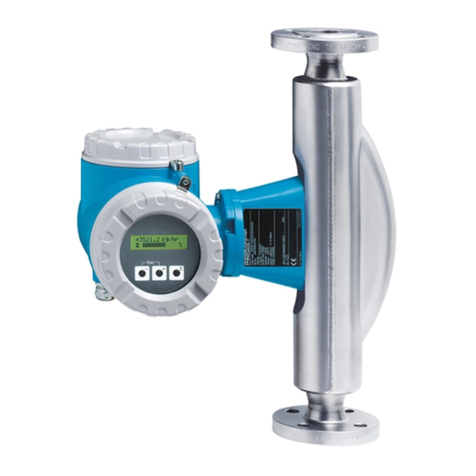
Endress+Hauser
Endress+Hauser HART Proline Promass 80 operating instructions

Hydrion
Hydrion 10 manual

Skold
Skold SCBA Phantom NFPA 2002 instruction manual

IFM Electronic
IFM Electronic efector 300 SD9000 operating instructions
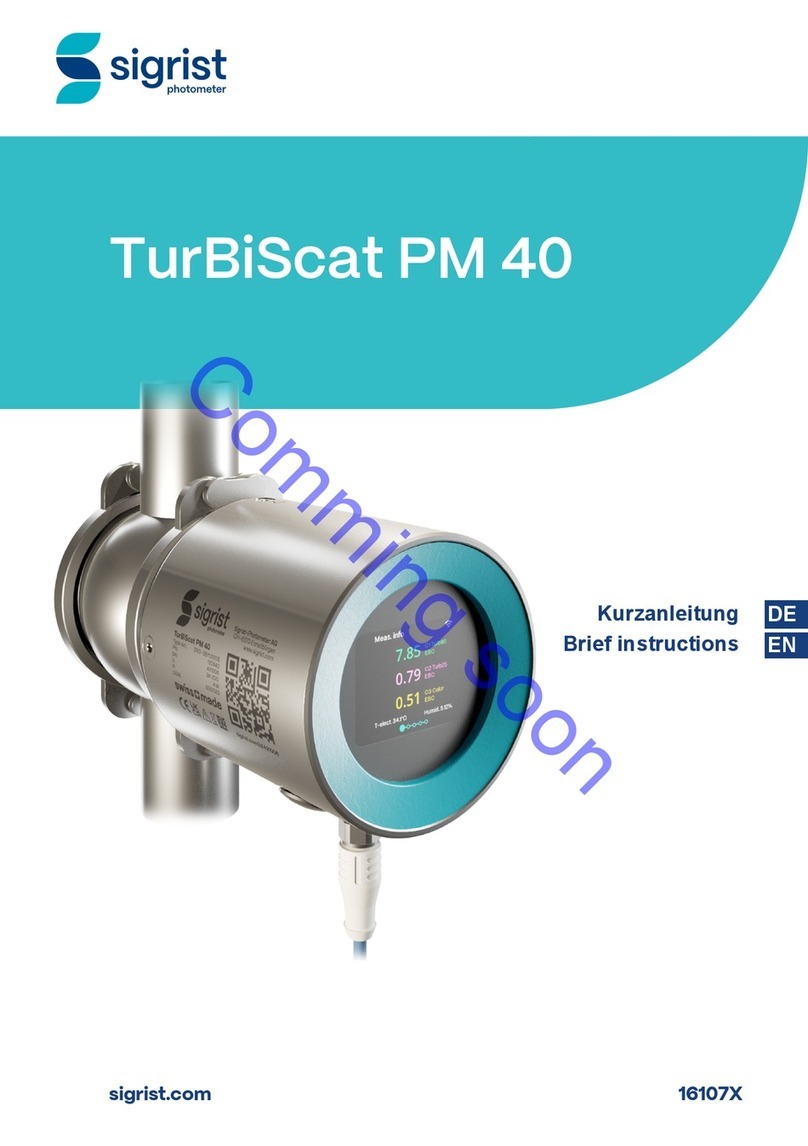
SIGRIST
SIGRIST TurBiScat PM 40 Brief instructions
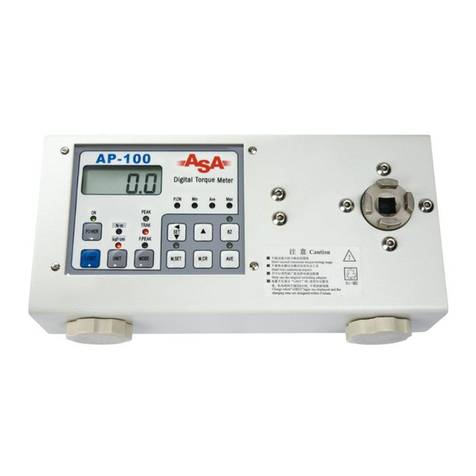
ASA Electronics
ASA Electronics AP-2 Product Introductions

